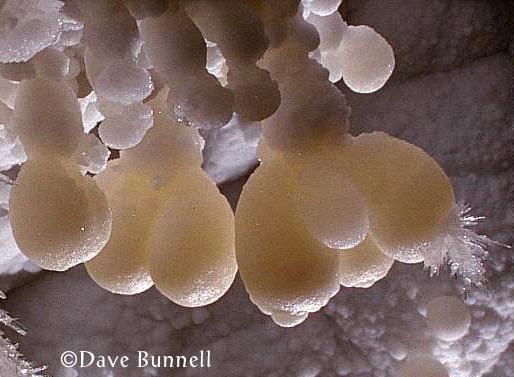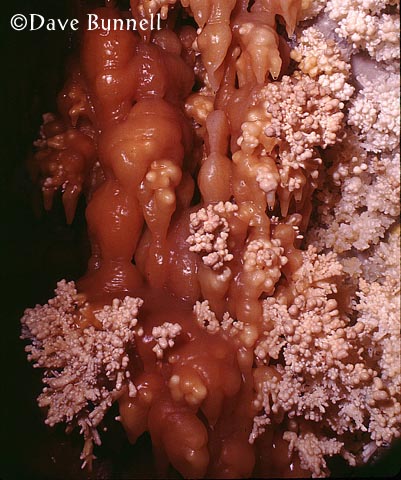
| Popcorn is a common
name for a very common type of coralloid.
It can be recognized by its gregarious nature and knob-like shape, the
latter of which it owes to its concentric layering of microcrystalline
calcite.
Though one of the most common of all cave formations, the origin of popcorn has been one of the more difficult to explain. Perhaps both the abundance and ambiguity of cave popcorn arise because it forms under so many conditions. Popcorn forms either in air (subaerially) or within still cave pools (subaqueously). In air, it is deposited from thin, evenly distributed solution films, but these films may be products of direct seepage, surface flow, drip water splash, capillary action, or condensation. Seepage, however, is probably the most common solution supply mechanism. Moisture within the underlying bedrock or cave calcite is wicked through the relatively porous matrix of a popcorn knob to its outer surface, where it feeds an array of growing crystal faces. The validity of this mechanism has been shown by laboratory experiments in which popcorn knobs have deposited precipitates from various solutions in which their bases are submerged. Unlike many forms of cave calcite, which grow chiefly due to the loss of carbon dioxide from their depositing solution, subaerial popcorn is largely the product of evaporation. As such, popcorn is often an excellent indicator of the subtle air currents that waft through even the deepest reaches of many caves. Evaporation will be fastest on surfaces that face 'upwind', and the observant caver comes to read popcorn's bushy growth on one side of a stalagmite not unlike the way a backpacker reads moss on one side of a tree trunk. Even more important to the cave explorer is the fact that where there is wind, there must be cave! Popcorn may not make tight crawling leads very comfortable, but it does make them more encouraging!
|


![]()
| Back to: | |
 |
Created: June 19, 1995 Last Updated: January 16, 1996 Author: Djuna Bewley |